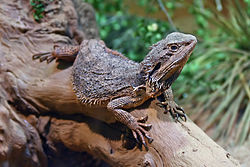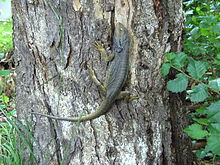- Eastern bearded dragon
-
Eastern bearded dragon 
The Eastern Bearded Dragon, Pogona barbata Scientific classification Kingdom: Animalia Phylum: Chordata Class: Reptilia Order: Squamata Suborder: Lacertilia Family: Agamidae Genus: Pogona Species: P. barbata Binomial name Pogona barbata
Cuvier, 1829The Eastern bearded dragon (Pogona barbata) is an agamid lizard found in wooded parts of Australia.[1] It is one of a group of species known commonly as Bearded Dragons. Other common names for this species include Jew Lizard and Frilly Lizard, the latter being a confusion between this and another dragon; the Frilled Lizard (Chlamydosaurus kingii).
It is most common in eastern Australia south of Cape York Peninsula, but specimens have been collected from Cape York, through central Australia, and even from the west coast of Australia. It is a large species of grey-black colour distinguished from its relative, the central bearded dragon, Pogona vitticeps, by its less robust body and the row of spines along the lateral edge of the body, which continues over the forearm (Cogger, 1992). It tends to be more cryptic in its behaviour than the Central bearded dragon and performs its bearded display more often. It has an adult snout-tail length of about 24 inches (60 cm). When threatened, in addition to its beard display, it gapes to display the bright yellow colour of the inside of its mouth. They eat small lizards and snakes, flowers, insects, fruits, and berries.
This species was previously known as Amphibolurus barbatus.[2]
Contents
Physical description
The eastern bearded dragon resembles its close relative the smaller central bearded dragon. It is usually grey-black in skin colour and is sometimes reddish-brown, yellowish-brown, or dark brown. Juveniles are paler in colour than the adults and have patterns that fade as they mature. As it matures it develops a subtle pale yellow, blue, or green tinge on the forepart of its head. The adult males can grow up to about 24 inches (60 cm), and females up to 20 inches (50 cm). The adult males have a dark grey to black "beard".
P. barbata retains venom glands on both the upper and lower jaws. (Fry et al. 2006)
Behavior
Eastern Bearded Dragons are diurnal. They are semi-arboreal and perch on exposed places such as tree branches or logs, retreating to lower and cooler places when too hot. The eastern bearded dragon is more aggressive than the central bearded dragon, demands more space and is less docile. The males are territorial and permit only females and juveniles in their territory. Dominant males are usually the biggest dragons and get the highest perch.
The eastern bearded dragon is also known to do the arm wave as a sign of submission or just for general communication.
When agitated or threatened, bearded dragons display their beard and gape.
Diet
 Juvenile eastern bearded dragon in the undergrowth of a blackberry bush. Note that the dark spot at the tip of the nose is the shadow of the same bush.
Juvenile eastern bearded dragon in the undergrowth of a blackberry bush. Note that the dark spot at the tip of the nose is the shadow of the same bush.
The eastern bearded dragon feeds on a variety of small vertebrates and invertebrates including crickets, small grasshoppers, worms, beetles, katydids, small mice, and small reptiles. In captivity they also eat a few vegetables. These include clover and dandelion flowers.
See also
- Bearded dragon
Footnotes
References
- Chris T. McAllister, Steve J. Upton, Elliott R. Jacobson and Wayne Kopit (1995-04). "A Description of Isospora amphiboluri (Apicomplexa: Eimeriidae) from the Inland Bearded Dragon, Pogona vitticeps (Sauria: Agamidae)". The Journal of Parasitology, Vol. 81, No. 2 (The American Society of Parasitologists) 81 (2). JSTOR 3283934.
- Fry, Brian G., et al. (2006). "Early evolution of the venom system in lizards and snakes." Nature. Letters. Vol. 439/2 February 2006. Pdf file available for download at: [1]
External links
Categories:- Agamidae
- Reptiles of Australia
- Reptiles of Western Australia
- Animals described in 1829
Wikimedia Foundation. 2010.


